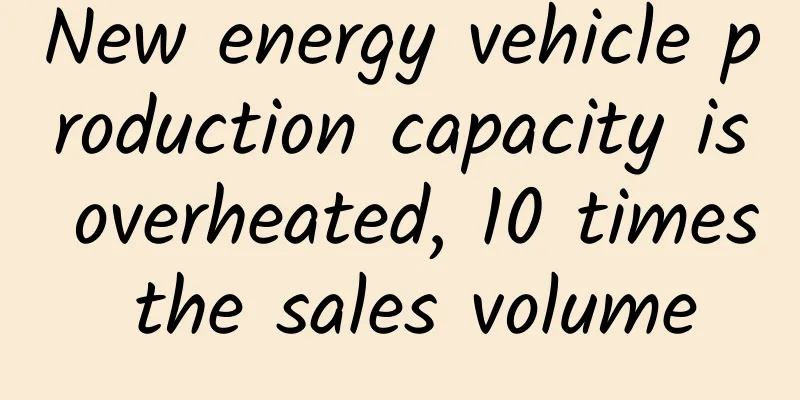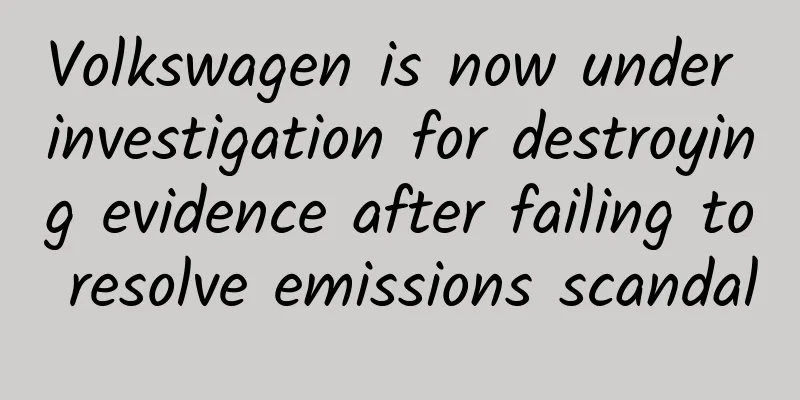New energy vehicle production capacity is overheated, 10 times the sales volume

|
New car-making forces have entered the mass production and delivery period. On May 29, Xiaopeng Motors held a ceremony at its headquarters in Guangzhou to deliver 100 registered Xiaopeng cars; on May 31, NIO also delivered 10 cars to the first batch of users... Behind the mass production and delivery of a large number of new energy vehicles, overcapacity has become a new problem that must be faced. Industry insiders said that with the influx of capital, the risk of overcapacity in the new energy vehicle industry is accumulating. If timely measures are not taken to deal with it, the new energy vehicle market will face a serious bubble crisis after "subsidy removal". Signs of overcapacity China has been the world's No. 1 producer and seller of new energy vehicles for three consecutive years, with a total of more than 1.8 million new energy vehicles sold. According to data from the China Association of Automobile Manufacturers, 777,000 new energy vehicles were sold in 2017, a year-on-year increase of 53.3%. Xu Haidong, assistant secretary general of the China Association of Automobile Manufacturers, said that China's electric vehicle market will grow by 40%-50% in 2018, and the annual sales of new energy vehicles may exceed 1 million. Given the gap between low-end vehicles in the market and consumer demand, the new energy vehicle industry has seen overcapacity. In April 2017, the Ministry of Industry and Information Technology, the National Development and Reform Commission, and the Ministry of Science and Technology jointly issued the "Medium- and Long-Term Development Plan for the Automobile Industry", which proposed that by 2020, the annual production and sales of new energy vehicles in China will reach 2 million. According to data released by the China Automobile Dealers Association, the overcapacity problem in China's new energy vehicle industry has become quite serious. From 2015 to the end of June 2017, more than 200 new energy vehicle projects have been implemented in China, with relevant investment amounts reaching more than 1 trillion yuan. Various automakers have publicly announced plans for new energy vehicle production capacity of more than 20 million vehicles, which is 10 times the target set in the "Medium- and Long-Term Development Plan for the Automobile Industry". According to the plan, most of these projects will be completed and put into production before 2020. In May 2018, Li Zhanchuan, deputy inspector of the Policy Research Office of the Ministry of Transport, revealed that subsidies for the purchase of new energy vehicles are expected to be completely withdrawn by 2020. In this regard, Huang Yonghe, a senior expert at the China Automotive Technology and Research Center, believes that after the subsidies are cancelled in 2020, if other policies cannot keep up and companies cannot sell their models, there is a possibility of substantial overcapacity. However, Cui Dongshu, secretary general of the National Passenger Vehicle Market Information Joint Conference, said in an interview with a Beijing Business Daily reporter that there is a problem of overcapacity in new energy vehicles, but it is only the planned overcapacity, and not all of it will actually be put into production. "Most of the new energy vehicle manufacturers will find it difficult to survive for more than five years," Cui Dongshu said. Overheated supply chain In fact, the problem of overcapacity has already put some new energy supply chain companies in trouble. Recently, news of a reduction in battery orders and factory shutdowns at major parks of new energy company Yinlong New Energy has continued to ferment. On May 30, there were also media reports that the Luoyang Industrial Park, which Yinlong New Energy invested 15 billion yuan to build, was progressing slowly. In 2016, after receiving 3 billion yuan of investment from Dong Mingzhu, chairman of Gree Electric Appliances, and others, Yinlong New Energy started a rapid expansion process. According to incomplete statistics, in 2017, Yinlong New Energy signed new energy industry projects with an investment scale of up to 80 billion yuan in 7 cities including Lanzhou, Tianjin, Panzhihua, and Zhuhai. Including these newly planned projects, Yinlong New Energy has as many as 11 industrial parks across the country. Rapid expansion has led to a sharp increase in costs. Li Zhi, vice president of Yinlong New Energy in charge of finance, said that since multiple industrial parks are currently under construction and the state’s subsidies for new energy vehicles have not yet arrived, Yinlong New Energy was indeed unable to make ends meet in 2017, with a funding gap of about 4 billion yuan. Not only Yinlong New Energy, but the entire domestic new energy battery industry is developing rapidly. Data shows that China's power battery shipments currently account for more than 70% of the global market share. From 2014 to 2016, the average annual growth rate of the domestic power battery industry was as high as 368%, 324% and 78.6% respectively. In 2016, the investment in the power battery field exceeded 100 billion yuan. Behind such high growth, the problem of overcapacity of power batteries has emerged. According to estimates, if the current production capacity is fully released, it will form a huge production capacity of 170GWh/year, which is about 7 times the actual market demand, and can meet the total demand of 5 million electric passenger cars and 500,000 electric buses per year. According to relevant plans, China's total power battery production capacity will reach 285GWh in 2020, but the demand for power batteries in the same period will only be 97GWh. Industry insiders said that in the context of overall overcapacity in the new energy vehicle industry, the power battery industry is characterized by structural overcapacity. The high-quality capacity of leading enterprises is sought after, while the backward capacity of small and medium-sized manufacturers cannot be well digested, and their living space will continue to be squeezed. Under the pressure of clearing excess capacity, some small and medium-sized manufacturers may transform into fields with lower technical requirements such as low-speed vehicles and small energy storage, thereby withdrawing from the competition in the power battery field. Policies cool down car manufacturing Although the "catfish effect" is conducive to the active market, relevant national departments have noticed the signs of overcapacity in new energy vehicles, and policies have begun to shift, shrinking the living space for speculators. The state issued a new subsidy policy for new energy vehicles from 2017 to 2018, which is 20% lower than that in 2016. In May 2018, the regulatory authorities revoked the exemption of vehicle purchase tax for 1,882 new energy vehicle models. Increasingly stringent policies have made it difficult for some speculators to survive in the market. In September 2016, the Ministry of Finance punished five new energy vehicle companies, including King Long Automobile and Shenzhen Wuzhoulong, for "cheating subsidies". Data showed that in the first half of 2017, King Long Automobile's net profit fell to 38 million yuan, a year-on-year decrease of more than 70%; Shenzhen Wuzhoulong's operating income in the same period was 4.8622 million yuan, and its loss reached 55.2024 million yuan. The National Development and Reform Commission recently issued the "Automotive Industry Investment Management Regulations (Draft for Comments)" which specifically stipulates that the provinces where new independent pure electric vehicle companies (including existing automobile companies building pure electric vehicle production capacity across passenger cars and commercial vehicles) are located should meet four conditions: First, the proportion of new energy vehicle ownership is higher than the national average; second, the electric vehicle charging infrastructure is relatively complete, and the car-to-pile ratio is higher than the national average; third, the cleanup of new energy vehicle zombie companies and zombie qualifications has been completed; fourth, the existing new pure electric vehicle company investment projects have all been completed, and the output has reached the construction scale. In the opinion of automobile analyst Jia Xinguang, the relevant regulations are equivalent to closing the door to new car-making companies whose purpose is to "make money". Only new car-making companies that are down-to-earth in making cars can hope to obtain production qualifications. As a winner of Toutiao's Qingyun Plan and Baijiahao's Bai+ Plan, the 2019 Baidu Digital Author of the Year, the Baijiahao's Most Popular Author in the Technology Field, the 2019 Sogou Technology and Culture Author, and the 2021 Baijiahao Quarterly Influential Creator, he has won many awards, including the 2013 Sohu Best Industry Media Person, the 2015 China New Media Entrepreneurship Competition Beijing Third Place, the 2015 Guangmang Experience Award, the 2015 China New Media Entrepreneurship Competition Finals Third Place, and the 2018 Baidu Dynamic Annual Powerful Celebrity. |
>>: BAIC New Energy obtains listing approval with fundraising of no more than 2 billion yuan
Recommend
So disgusting! These 8 things are very dirty and you may use them every day without knowing it!
Towels, toothbrushes, rags, chopsticks and other ...
Why does "Hua Xizi" combine "online + offline" marketing?
" Hua Xizi " was born in Hangzhou, Chin...
Why is the fifth day of the first lunar month called "Po Wu"? How to "Po"?
This article was reviewed by Shao Lin, a popular ...
Galaxy Note4 can't save Samsung from decline
Samsung Electronics is expected to launch the Gal...
4 modules teach you how to use marketing thinking to seduce girls
"I will be 27 after this birthday. I will ch...
Two iPhones and a Watch: Apple's "late" press conference
In September, a month full of new phones, after m...
Tencent applies for "WeChat Cloud" trademark, chat record cloud storage service confirmed, 50% of netizens think it is unnecessary
According to Tianyancha, Tencent is applying for ...
Why do I always have two annoying bulges on my knees? Can I straighten them?
Every time I see a female star's legs, I envy...
Microsoft Edge 93 for Android released
[[422344]] Following the desktop update, Microsof...
Can multi-screen interaction on smart TVs really improve user experience?
Multi-screen interaction centered on TV has gradu...
The magical "Sarebo" and the noble "Jiusi Zheer"
In the middle of Lushan Scenic Area in Xichang, t...
Does a child's IQ come from the father or the mother? Genetics experts reveal the secret
Have you noticed that we often say "alma mat...
iPhone can still be tracked even after it is turned off! Netizens: Don’t worry if your phone is lost
It has been a while since Apple announced the iOS...
Google promotion: teach you how to do Google search advertising
Google Ads is the most important form of advertis...
Brand war under the epidemic
We all know that the former chairman of Coca-Cola...









